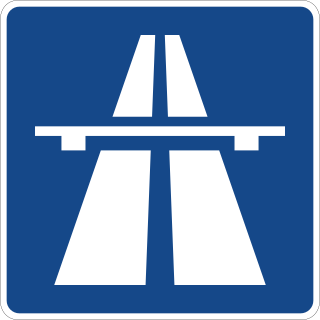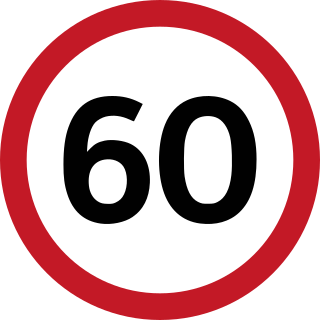
Speed limits on road traffic, as used in most countries, set the legal maximum speed at which vehicles may travel on a given stretch of road. Speed limits are generally indicated on a traffic sign reflecting the maximum permitted speed - expressed as kilometres per hour (km/h) and/or miles per hour (mph). Speed limits are commonly set by the legislative bodies of national or provincial governments and enforced by national or regional police and judicial authorities. Speed limits may also be variable, or in some places nonexistent, such as on most of the Autobahnen in Germany.

A limited-access road, known by various terms worldwide, including limited-access highway, dual-carriageway, expressway, and partial controlled access highway, is a highway or arterial road for high-speed traffic which has many or most characteristics of a controlled-access highway, including limited or no access to adjacent property, some degree of separation of opposing traffic flow, use of grade separated interchanges to some extent, prohibition of slow modes of transport, such as bicycles, (draught) horses, or self-propelled agricultural machines; and very few or no intersecting cross-streets or level crossings. The degree of isolation from local traffic allowed varies between countries and regions. The precise definition of these terms varies by jurisdiction.
The Autostrade are roads forming the Italian national system of motorways. The total length of the system is about 6,758 kilometres (4,199 mi). In North and Central Italy, the Autostrade mainly consists of tollways managed by Autostrade per l'Italia, a holding company controlled by Cassa Depositi e Prestiti. Other operators include ASTM, ATP, and Autostrade Lombarde in the north-west; Autostrada del Brennero, A4 Holding, Concessioni Autostradali Venete, and Autovie Venete in the north-east; Strada dei Parchi, SALT, SAT, and Autocisa in the center; and CAS in the south.

The Autobahn is the federal controlled-access highway system in Germany. The official German term is Bundesautobahn, which translates as 'federal motorway'. The literal meaning of the word Bundesautobahn is 'Federal Auto(mobile) Track'.

Speed limits in the United States are set by each state or territory. States have also allowed counties and municipalities to enact typically lower limits. Highway speed limits can range from an urban low of 25 mph (40 km/h) to a rural high of 85 mph (137 km/h). Speed limits are typically posted in increments of five miles per hour (8 km/h). Some states have lower limits for trucks, some also have night and/or minimum speed limits.
This is a list of the world's record-breaking top speeds achieved by street-legal production cars. For the purposes of this list eligible cars are defined in the list's rules. This list uses a different definition to the List of automotive superlatives. The variation is because the term production car is otherwise undefined.

Road speed limits in Ireland apply on all public roads in the state. These are signposted and legislated for in kilometres per hour. Speed limits are demarcated by regulatory road signs. These consist of white circular signs with a red outline. Speed limits are marked in black with "km/h" below the speed limit. Smaller "repeater" speed limit signs are used along stretches of road where there is no change in speed limit, in order to remind motorists currently on the road and to inform traffic merging from junctions that a certain speed limit applies.
Speed limits in Australia range from 5 km/h (3.1 mph) shared zones to 130 km/h (81 mph). Speed limit signage is in km/h since metrication on 1 July 1974. All speed limits are multiples of 10 km/h – the last digit in all speed signs is zero. Speed limits are set by state and territory legislation albeit with co-ordination and discussion between governments.

The National Maximum Speed Limit (NMSL) was a provision of the federal government of the United States 1974 Emergency Highway Energy Conservation Act that effectively prohibited speed limits higher than 55 miles per hour (89 km/h). It was drafted in response to oil price spikes and supply disruptions during the 1973 oil crisis and remained the law until 1995.

A speed limit is the limit of speed allowed by law for road vehicles, usually the maximum speed allowed. Occasionally, there is a minimum speed limit. Advisory speed limits also exist, which are recommended but not mandatory speeds. Speed limits are commonly set by the legislative bodies of national or local governments.
Canadian speed limits are set by different levels of government, depending on the jurisdiction under which the road falls, resulting in differences from province to province. The limits have been posted in kilometres per hour (km/h) since September 1, 1977. Before then, when Canada used Imperial units, speed limits were in miles per hour (mph).
A speed limiter is a governor used to limit the top speed of a vehicle. For some classes of vehicles and in some jurisdictions they are a statutory requirement, for some other vehicles the manufacturer provides a non-statutory system which may be fixed or programmable by the driver.

Road speed limits in the United Kingdom are used to define the maximum legal speed for vehicles using public roads in the UK. Speed limits are one of the measures available to attempt to control traffic speeds, reduce negative environmental effects of traffic, increase fuel use efficiency and satisfy local community wishes. The speed limit in each location is indicated on a nearby traffic sign or by the presence of street lighting. Signs show speed limits in miles per hour (mph) or the national speed limit (NSL) sign may be used.

Speed limits in Germany are set by the federal government. All limits are multiples of 10 km/h. There are two default speed limits: 50 km/h (31 mph) inside built-up areas and 100 km/h (62 mph) outside built-up areas. While parts of the autobahns and many other freeway-style highways have posted limits up to 130 km/h (81 mph) based on accident experience, congestion and other factors, many rural sections have no general speed limit. The German Highway Code (Straßenverkehrsordnung) section on speed begins with the requirement which may be rendered in English:
Any person driving a vehicle may only drive so fast that the car is under control. Speeds must be adapted to the road, traffic, visibility and weather conditions as well as the personal skills and characteristics of the vehicle and load.

Speed limits in the Czech Republic vary depending on the type of road, and whether the road is within a settlement or not. The top speed limit is 130 km/h (81 mph) for motorways outside of settlements, whereas on regular roads within a settlement the speed limit is 50 km/h (31 mph). outside of the settlement and other than motorway the speed limit is 90 km/h. Various other special restrictions are applied for certain types and weight categories of vehicle.

The default speed limits in the Netherlands are 50 km/h (31 mph) inside built-up areas, 80 km/h (50 mph) outside built-up areas, 100 km/h (62 mph) on expressways (autowegen), and, as of 16 March 2020, 100 km/h from 6:00 to 19:00 and 130 km/h from 19:00 to 6:00 on motorways (autosnelwegen).

Speed limits in the Philippines are specified in Republic Act No. 4136, or the Land Transportation and Traffic Code of the Philippines, which took effect on its approval on June 20, 1964. The act covers a number of areas other areas than speed limits, and was amended regarding some of those areas by Republic Act No. 10930, which was approved on August 2, 2017. As of 11 July 2021, RA 4136 is listed as current by the Land Transportation Office of the Philippines.
30 km/h zones and the similar 20 mph zones are forms of speed management used across areas of urban roads in some jurisdictions. The nominal maximum speed limits in these zones are 30 kilometres per hour (19 mph) and 20 miles per hour (32 km/h) respectively. Although these zones do have the nominal speed limit posted, speeds are generally ensured by the use of traffic calming measures, though limits with signs and lines only are increasingly used in the UK.

Speed limits in the United States vary depending on jurisdiction. Rural freeway speed limits of 70 to 80 mph are common in the Western United States, while such highways are typically posted at 65 or 70 mph in the Eastern United States. States may also set separate speed limits for trucks and night travel along with minimum speed limits. The highest speed limit in the country is 85 mph (137 km/h), which is posted on a single stretch of tollway in exurban areas outside Austin, Texas. The lowest maximum speed limit in the country is 30 miles per hour (48 km/h) in American Samoa.











